This content explores ten key moments in the evolution of electronic music. It starts with the invention of the Telharmonium in 1897, which paved the way for electronic music by generating sounds using electricity. The Theremin, invented in the 1920s, relied on hand movement rather than physical contact to produce sound. The Moog synthesizer’s invention in 1964 revolutionized electronic music by allowing musicians to manipulate various elements to create unique sounds. Kraftwerk, a German band, played a crucial role in shaping electronic pop music in the 1970s. The emergence of hip-hop in the 1980s led to electronic sounds being used in popular music production. House music, which emerged in the 1980s, blended electronic instruments with disco and funk influences. Techno music originated in Detroit in the 1980s and quickly spread globally, influencing electronic music scenes worldwide. Drum and bass, which emerged in the 1990s, pushed the boundaries of electronic music with fast-paced breakbeats and intricate production techniques. The 2000s saw the rise of EDM, characterized by energetic beats and anthemic melodies. Present-day electronic music continues to diversify with the accessibility of music production tools. These ten moments represent significant milestones in the evolution of electronic music and have shaped the musical landscape.
1. The Birth of Electronic Music: The Telharmonium (1897)
In the late 19th century, the invention of the Telharmonium by Thaddeus Cahill paved the way for electronic music. This massive instrument generated sounds through tone wheels and electromagnets, producing notes that could be amplified and transmitted over telephone lines. Though it was not widely adopted, the Telharmonium was a crucial precursor to electronic music as it demonstrated the concept of generating sounds using electricity.
2. The Theremin: Music without Physical Contact (1920s)
The Theremin, invented by Russian Leon Theremin in the early 1920s, marked a significant advancement in electronic music. This instrument stands out due to its unique method of sound production. Rather than requiring physical contact like traditional instruments, the Theremin relied on the movement of hands in proximity to two antennas, controlling pitch and volume. Its haunting and ethereal sound became iconic and found its way into many classical compositions.
3. The Advent of the Moog Synthesizer (1964)
Dr. Robert Moog’s invention of the Moog synthesizer in 1964 revolutionized the world of electronic music. This portable and modular synthesizer allowed musicians to create a wide variety of sounds by manipulating voltage-controlled oscillators, filters, and amplifiers. It quickly gained popularity, finding its place in both experimental and mainstream music, influencing genres like progressive rock, disco, and new wave.
4. Kraftwerk: Pioneers of Electronic Pop (1970s)
The German band Kraftwerk played a crucial role in shaping the electronic music landscape in the 1970s. Through their innovative use of synthesizers, drum machines, and vocoders, they created a unique blend of electronic pop music. Their album “Autobahn” (1974) became a breakthrough success, with its title track embodying the futuristic and mechanical soundscape they were known for.
5. Hip-Hop’s Rise with Sampling (1980s)
In the 1980s, the emergence of hip-hop music presented a new avenue for electronic sounds. Producers such as Grandmaster Flash and Afrika Bambaataa utilized samplers to manipulate and rearrange existing recordings, creating entirely new compositions. This era marked the beginning of the widespread use of electronic equipment in popular music production.
6. The Birth of House Music (1980s)
House music emerged from the dance clubs of Chicago in the mid-1980s, blending electronic instruments and drum machines with disco and funk influences. DJs like Frankie Knuckles and Marshall Jefferson paved the way for this genre, creating a sound characterized by repetitive beats, synthesized basslines, and soulful vocals. House music would go on to influence countless electronic genres, including techno and trance.
7. The Rise of Techno (1980s-1990s)
Originating in Detroit, Michigan, during the 1980s, techno music expanded upon the foundations laid by house music. Artists like Juan Atkins, Derrick May, and Kevin Saunderson crafted a futuristic sound using drum machines, synthesizers, and samplers to create intricate rhythms and otherworldly melodies. Techno quickly spread globally, influencing electronic music scenes worldwide.
8. The Birth of Drum and Bass (1990s)
Drum and bass emerged in the early 1990s in the United Kingdom, combining elements of hip-hop, breakbeat, and electronic music. Its fast-paced breakbeats, deep basslines, and intricate production techniques pushed the boundaries of what was possible with electronic music. Artists such as Goldie and Roni Size brought this genre to mainstream success, and it remains a vital part of the electronic music landscape.
9. The Popularization of EDM (Electronic Dance Music) (2000s)
The 2000s witnessed the rise of electronic dance music, commonly abbreviated as EDM. This genre, characterized by its energetic beats, anthemic melodies, and incorporation of electronic elements, found enormous commercial success. Major festivals like Tomorrowland and Ultra Music Festival became cultural phenomena, showcasing the popularity and global reach of EDM artists such as Swedish House Mafia, Avicii, and David Guetta.
10. The Era of Modern Electronic Music (Present)
In recent years, electronic music has continued to evolve and diversify. With advancements in technology, artists have access to a vast range of synthesizers, effects, and production software. Subgenres like dubstep, trap, and future bass have gained prominence, pushing the boundaries of sound and attracting a new generation of fans. The accessibility of music production tools has also democratized the creation process, allowing bedroom producers to make an impact on the electronic music scene like never before.
In conclusion, the evolution of electronic music has seen numerous pivotal moments throughout history. From the early experiments with the Telharmonium and Theremin to the rise of EDM and the modern-day proliferation of electronic subgenres, this genre has continuously pushed the boundaries of musical expression. These ten key moments represent significant milestones in the evolution of electronic music, providing a rich tapestry of innovation and creativity that continues to shape the musical landscape.
